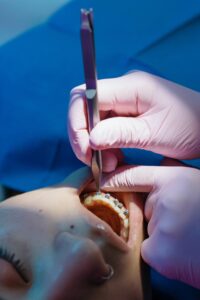I’m sure that if you are reading this, you have heard about the gut microbiome and how important it is, not just for the health of our digestive system but for our overall health. (If you’d like a refresher, read my posts Beat The Bloat Part 4: The Gut Microbiome and The Many Benefits of Eating a Rainbow.) Whilst the gut microbiome is the largest and most researched microbiome in the human body, it is not the only microbiome. We are learning more and more about multiple microbiomes throughout the human body; the skin, lungs, urinary and reproductive tracts and the mouth all have their own unique microbiomes. Of these, it’s the oral microbiome that I want to explore here. You might be surprised to learn that it influences much more than tooth decay!
The Oral Environment
The mouth provides a hospitable environment for microbes. It is warm and moist, and nutrients are delivered straight into it and then transported around it by the saliva. This may be why the oral microbiome is the second largest and most diverse microbiome in the human body, after the gut; it contains over 700 different species of bacteria as well as fungi, viruses and protozoa(1). There are opportunities for microbes to colonise different habitats, such as the gums, the surfaces of the teeth, cheeks, tongue etc.(2)
Because bacteria in the mouth are constantly being exposed to foreign microbes introduced via food, they have evolved to protect themselves. They do this by living together in colonies and constructing protective enclosures called biofilms around them. Biofilms can attach to the surfaces of our teeth, and if we do not brush our teeth, they will stay there. The composition of the bacteria that are in a biofilm can influence whether or not this results in tooth decay. Any other non-shedding objects that are introduced into the mouth, such as plates or orthodontic braces, can result in increased biofilm formation.

In a healthy microbiome, the many different microbial species in the mouth live in balance. A shift away from balance is called dysbiosis. Unlike in the gut microbiome, where there can often be an infection with one or two overgrown pathogenic species, it is not common for just one species to overgrow in the mouth. Dysbiosis is more a general imbalance. Your diet strongly influences your oral microbiome, as we will see later.
Links with Oral Disease
It is easy to imagine how oral dysbiosis can be linked to conditions in the mouth itself, such as gingivitis (gum disease), periodontitis (in which gingivitis has advanced, resulting in bacteria collecting in the cavities between teeth and gums, receding gums and even bone loss) and tooth decay.
- Gingivitis can be triggered by small numbers of pathogenic bacteria in the mouth as well as by excessive biofilm. Oral dysbiosis can cause inflammation which can then cause more severe periodontal disease.
- When we eat a diet high in simple carbohydrates and sugars, oral bacteria ferment the carbohydrates resulting in an acidic environment in the mouth. This can cause minerals to be pulled out of teeth, and if the high acid environment persists because we snack on carbohydrates too frequently, this can cause tooth decay. Once the oral environment is acidic, it encourages bacteria which tolerate and produce acid to thrive, setting up a vicious circle.
Links with Systemic Diseases
However, the effects of oral dysbiosis don’t end in the mouth. People with periodontal disease have much higher risks of having other chronic conditions too. Some of the conditions linked to periodontal disease include:
- Cardiovascular disease
- Type 2 diabetes
- Rheumatoid arthritis
- Alzheimer’s disease(3)
- Pancreatic, lung and oral cancer(4)
Many of these associations are two-way. For example, people with type 2 diabetes have a threefold increased risk of having periodontal disease, and having periodontal disease worsens blood sugar control(5). What is going on that links these seemingly unrelated conditions to the mouth?
Inflammation
An overgrowth of pathogenic oral bacteria can stimulate our immune system and drive chronic, low grade inflammation. This contributes to periodontal disease, but the inflammation not limited to the mouth; it becomes systemic(6). It is very easy for inflammatory molecules produced in the mouth to enter the bloodstream if the gums are inflamed (or even bleeding) and move around the body. If you’ve followed me for any length of time you will probably be tired of hearing me say that chronic, low grade inflammation is a driver of many chronic conditions, from diabetes to cancer.
Of course, oral bacteria can also be swallowed, make their way to the gut and influence the microbiome there.
How to Keep Your Oral Microbiome Healthy
Firstly, nothing that I mention here is intended to be a substitute for regular care from your dentist and hygienist. They can help to remove biofilms, spot the first signs of gum disease and advise you on how you should be caring for your teeth. Don’t avoid them, and don’t skimp on your oral hygiene! Unlike mucosal surfaces such as the skin, our teeth are hard and do not shed, so biofilms attached to the teeth will stay there and multiply unless they are mechanically removed by brushing and cleaning.

Studies have shown that the ancient Ayurvedic practice of oil pulling is just as effective at reducing oral plaque and gingivitis as Chlorhexidine mouthwashes(7). For a demonstration of how to oil pull with coconut oil, watch my video here.
Your diet can have a significant impact on your oral microbiome. High sugar foods, simple (“white”) carbohydrates, acidic soft drinks and frequent snacking can all contribute to an acidic environment which promotes tooth decay. The acidic environment also encourages the overgrowth of opportunistic bacteria which can cause inflammation, periodontal disease and systemic disease. Smoking and alcohol also have adverse effects on the oral microbiome.
In contrast, dietary factors which can encourage a healthy oral microbiome include:

- Polyphenols – compounds in herbs, spices, tea and berries which encourage beneficial bacteria
- Vitamin A (from animal sources such as liver as well as from plant sources of beta-carotene such as carrots, kale, butternut squash) – supports the production of immune factors in saliva
- Zinc (oysters, venison, legumes, ginger, nuts and seeds) – supports immunity
- Fermented foods – contain beneficial bacteria which may help to break down biofilms around oral bacteria
- Good hydration – essential for salvia production, and saliva contains immunoglobulins which help to regulate the oral microbiome and keep it balanced
- Instead of eating white refined carbohydrates and sugars, choose complex carbohydrate sources like whole grains, starchy vegetables and pulses
Making sure that your vitamin D level is optimal is another way of regulating the immune system so that it can keep the oral microbiome balanced. As saliva is so important, it is really important not to let the mouth dry out, so breathing through the nose and not the mouth is another key factor.
If you already have gingivitis then this could be causing a systemic inflammatory response in your body. As well as working to support the root cause (rebalance your oral microbiome), an anti-inflammatory diet would help to reduce inflammatory molecules elsewhere in the body. Think a rainbow of vegetables, plenty of herbs and spices and essential fats from oily fish, walnuts, chia and flaxseeds.
Finding Out the Composition of Your Oral Microbiome
If you are concerned about the health of your oral microbiome or are simply interested in finding out more about its composition, then you may wish to consider an oral microbiome test, Oral EcologiX, which is available from UK laboratory Invivo. A simple saliva sample is all that is needed. Contact me if you are interested and we can take a look into your mouth!
References
- Deo, P.N and Deshmukh, R. (2019). ‘Oral microbiome: Unveiling the fundamentals’, Journal of Oral and Maxillofacial Pathology, 23(1), 122-128. Available at https://www.ncbi.nlm.nih.gov/pmc/articles/PMC6503789/ (Accessed 17 May 2021).
- Kilian, M., Chapple, I.L.C., Hannig, M. et al. (2016). ‘The oral microbiome – an update for oral healthcare professionals’, British Dental Journal, 221(10), 657-666. Available at https://www.nature.com/articles/sj.bdj.2016.865 (Accessed 17 May 2021).
- Willis, J.R. and Gabaldon, T. (2020). ‘The Human Oral Microbiome in Health and Disease: From Sequences to Ecosystems’, Microorganisms, 8(2), 308. Available at https://www.ncbi.nlm.nih.gov/pmc/articles/PMC7074908/ (Accessed 17 May 2021).
- Michaud, D.S., Fu, Z., Shi, J. et al. (2017). ‘Periodontal Disease, Tooth Loss, and Cancer Risk’, Epidemiological Reviews, 39(1), 49-58. Available at https://www.ncbi.nlm.nih.gov/pmc/articles/PMC5868279/ (Accessed 17 May 2021).
- Preshaw, P.M., Alba, A.L., Herrera, D. et al. (2011). ‘Periodontitis and diabetes: a two-way relationship’, Diabetologia, 55(1), 21-31. Available at https://www.ncbi.nlm.nih.gov/pmc/articles/PMC3228943/ (Accessed 17 May 2021).
- Cecoro, G., Annunziata, M., Iuorio, M.T. et al. (2020). ‘Periodontitis, Low-Grade Inflammation and Systemic Health: A Scoping Review’, Medicina (Kaunas), 56(6), 272. Available at https://www.ncbi.nlm.nih.gov/pmc/articles/PMC7353850/ (Accessed 17 May 2021).
- Gbinigie, O., Onakpoya, I., Spencer, E. et al. (2016). ‘Effect of oil pulling in promoting oro dental hygiene: A systematic review of randomized clinical trials’, Complementary Therapies in Medicine, 26, 47-54. Available at https://pubmed.ncbi.nlm.nih.gov/27261981/ (Accessed 18 May 2021).

